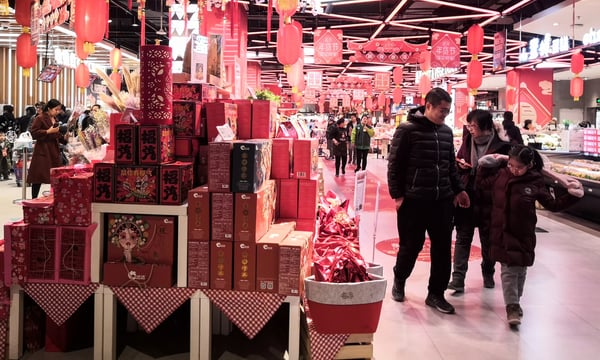In the face of renewed China-U.S. trade tensions, China’s leadership is not merely enduring pain – it is instrumentalizing it. The Chinese Communist Party (CCP) is repurposing economic hardship as political capital, constructing a narrative in which struggle becomes virtue, sacrifice becomes loyalty, and national suffering becomes a source of pride. Rather than seeking immediate economic relief, Beijing is reinforcing regime legitimacy through a blend of controlled messaging, patriotic campaigns, and selective state support.
But beneath the surface of unity lies a quieter undercurrent of disillusionment. China’s younger, more digitally connected population is proving harder to mobilize through state narratives alone. The real test for the CCP is not whether it can survive hardship, but whether it can continue to extract legitimacy from it.
From Tariffs to Triumph: The Propaganda of Pain
The latest trade conflict, reignited in early 2025 with U.S. tariffs reaching 145 percent on Chinese goods, has disrupted global supply chains and dealt a visible blow to China’s export economy. Manufacturing indicators fell below the threshold for expansion, youth unemployment crept past 17 percent, and consumer sentiment slumped.
Yet official messaging paints a defiant portrait. According to Xinhua, China is not struggling. Instead, it is “resisting economic coercion with Chinese characteristics.” Patriotic campaigns emphasize self-reliance and dignity in adversity. In April, the Ministry of Foreign Affairs released a video titled “Never Kneel Down!” Framed like a cinematic war trailer, it juxtaposed grainy footage of Chinese factories with slogans like “Pain today, pride tomorrow,” accusing the United States of waging a new kind of imperialism.
This messaging is not accidental. It is the CCP’s ideological answer to an increasingly asymmetric confrontation: to convert economic damage into a narrative of righteous resistance. Rare earth export restrictions and supply chain disruptions are framed not as costs, but as tools of sovereign assertion. The hardships tariffs create are presented as trials through which national honor is refined.
Rewriting the Social Contract: From Prosperity to Struggle
Historically, the post-1978 Chinese social contract rested on a simple pact between the CCP and ordinary people: prosperity in exchange for political acquiescence. But as growth slows and inequality deepens, that contract is fraying. Rather than attempting to restore the old bargain, the CCP is actively reworking it, positioning ideological unity and patriotic duty as the new foundations of civic responsibility.
State messaging has shifted accordingly. Patriotic education campaigns in schools, state-backed influencers on Douyin, and short video platforms like Bilibili are used to disseminate slogans emphasizing sacrifice, collective effort, and “struggle for the nation.” Civil servants and state-owned enterprise workers are regularly encouraged to take part in themed study sessions on “economic war preparedness,” and young professionals are reminded that hardship today is an investment in a stronger China tomorrow.
Strategic sectors – especially semiconductors, green tech, and artificial intelligence – continue to receive robust support, with targeted funding exceeding $300 billion under the “Made in China 2025” framework. At the same time, less strategic parts of society are asked to bear greater burdens. Migrant workers face stagnant wages, rural youth remain excluded from urban job markets, and access to healthcare and housing remains bifurcated by the hukou system.
This uneven allocation of relief is not incidental. It reflects a deliberate strategy: to redirect expectations away from universal prosperity and toward selective sacrifice for national goals. It is a new kind of social compact, one that prioritizes loyalty to national-level causes over daily livelihood concerns.
Public Response: Slogans Meet Silence
For older generations shaped by the Cultural Revolution or post-Tiananmen recovery, hardship narratives retain a certain resonance. But among younger Chinese, the reception is increasingly ambivalent. Even as official slogans call for “struggle as glory,” subcultures like “lying flat” (躺平) and “let it rot” (摆烂) gain quiet traction. These expressions, spread widely on forums like Zhihu and Bilibili, reflect a passive resistance to a system that promises collective progress but offers limited personal mobility.
University graduates face a hyper-competitive job market, with underemployment rising despite state-sponsored job fairs and training campaigns. Many view official encouragement as empty performance. Online satire frequently mocks official job postings for requiring years of experience for entry-level roles or promoting “volunteering” as a solution to unemployment.
Rather than openly challenging the CCP, these sentiments manifest as withdrawal: disaffection, cynicism, or symbolic nonparticipation. The party recognizes this drift. In response, it has launched “youth revitalization” campaigns: featuring military-style boot camps, nationalist film festivals, and “entrepreneurship zones” for Gen Z. But effectiveness remains limited. The gap between official narrative and lived experience is growing more difficult to bridge.
Legitimacy Under Pressure
The CCP’s capacity to endure pain is formidable, but pain alone cannot sustain legitimacy. The party’s long-term authority rests not just on control or propaganda, but on its ability to maintain credibility across generations.
To bolster that credibility, Xi Jinping’s administration has leaned heavily on discipline and centralization. Yet the cost of this top-down rigidity is growing. A system that prizes loyalty above flexibility risks alienating a society that increasingly values opportunity, dignity, and transparency. What once were powerful tools of consolidation – discipline, sacrifice, central planning – are now also sources of alienation for a new class of digital natives.
China’s international posture further complicates the picture. While exports to ASEAN and the EU have cushioned the loss of U.S. markets, global perceptions of China are hardening. Western policymakers may overestimate the leverage of tariffs and sanctions, but they underestimate the internal toll that prolonged strategic decoupling will inflict on Chinese society and the political finesse required to manage it.
Endurance Without Enthusiasm?
The CCP has turned hardship into a governing principle. It frames economic difficulty as evidence of national dignity and hardship as heroic. This strategy allows China to absorb pressure without appearing to retreat. But it also raises a more profound question: Can legitimacy thrive on sacrifice alone?
If the 2025 trade conflict is any indication, China’s ability to endure pain remains robust, but its ability to inspire enthusiasm is less certain. Young Chinese are not revolting, but they are increasingly indifferent. They may not challenge the state, but neither are they convinced by its slogans.
The CCP’s future strength will hinge not just on resilience, but on relevance. If it cannot modernize its message to meet a more skeptical, self-aware society, then its most loyal asset, public patience, may slowly slip beyond reach.






